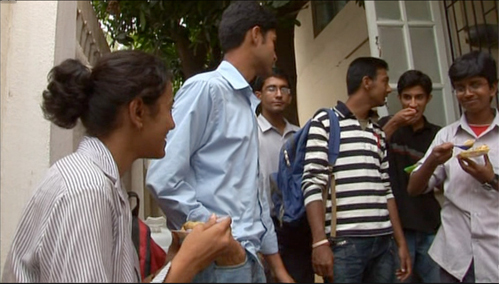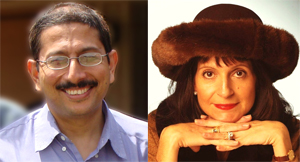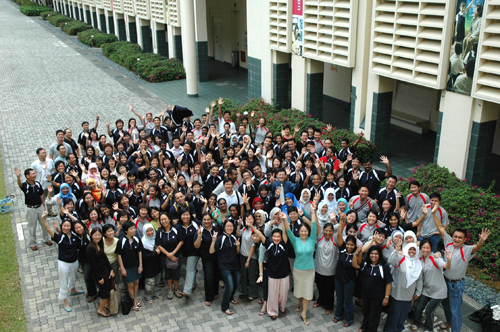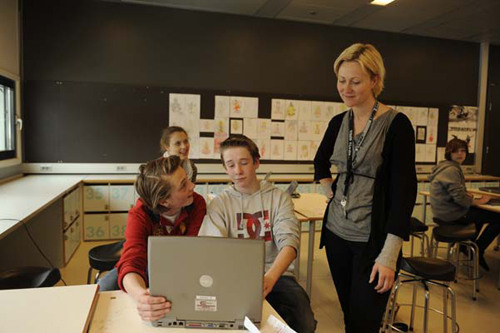
המטרה היא חינוך. יש לנו 64 million students in it. India has about 320 מיליון (גילים 5 ל 14). סרטו של בוב קומפטון, שני מיליון דקות, observed that many students in India and China spend more time acquiring academic knowledge. What works in the Indian culture is going to be different from what works in our American culture. Some might argue we spend our time developing the well-rounded child . Does it matter to many Americans that while we study the Super Bowl and Glee, Indian and Chinese students spend more time building their intellectual foundation? כן, poverty and weak infrastructure are challenges India faces, but often when you’re coming from behind you’re more hungry to achieve. These are our global friends ו our competitors.
It is India Time — India will participate in the next PISA test (תכנית להערכת סטודנטים בינלאומיים) — בפעם הראשונה. There have been a number of new educational initiatives that have made this possible. One of the major programs was explained to me by Sridhar Rajagopalan (Head of Educational Initiatives), גבר בשליחות לחולל מהפכה בדרך ההודים ואחרים חושבים על למידה.
איזה סוג של מערכת חינוך יאפשר להודו יש את הכישורים הדרושים כדי להתחרות אנשים בעולם?
המטרה תהיה לקבל מערכת חינוך המאפשרת לאנשים לממש את הפוטנציאל המלא שלהם אקדמי. זה יאפשר הודו להתחרות באופן גלובלי ויש לי חברה מקומית שבו אנשים העוסקים באופן משמעותי והם מסוגלים לפתור את הבעיות העומדות בפני החברה שלהם. המערכת הייתה צריכה להתמקד במצוינות ומחקר אקדמיים, וגם בפיתוח אנשים רחומים ואכפתיות.
מה הם האתגרים המרכזיים שלך?
אחת הבעיות הבסיסיות במערכת החינוך ההודית הפרצופים הוא ההתמקדות הגבוהה שלנו בשינון. הבעיה של שינון נדונה במדינות רבות ברחבי העולם, כולל אמריקה. עם זאת, אני חושב ששינון הוא בעיה חמורה בהודו. שינון זה כמו לומר שאתה לא צריך להבין; you don’t need to be able to think and apply knowledge; as long as you can recite what is in a lesson in a textbook, that’s fine. This problem is reflected in our school leaving exams. It’s reflected in the fact that certification is the all important focus, versus learning. The problem is even more serious in rural areas where children are struggling to develop basic skills. So our system needs to focus on learning with understanding, developing critical thinking skills, and developing a lifelong passion for learning.
So if you change the way you test, it might influence the way children are taught?
בהחלט. The primary purpose for which we use testing is so that the system, ההורים, המורים, and the government understand that students are learning. If we change the way we currently test, we can improve both the way we teach and the quality of what children learn. We are beginning to make the first few steps in this direction.
What have you done in the past 5 – 10 years to improve student assessment?
We began our work with low stakes assessment. The first step involves regular assessments. The purpose is to diagnose and to give a benchmark. Our diagnostic work has been considered cutting edge compared to the rest of the world. One of our advantages is our very large sample base of students. The second advantage we have is that we go into great depth in our diagnostic work, e.g. what do students understand about angles. When we do a student assessment we capture the students’ responses on video. The videos become very helpful in training and supporting the teacher.
The next step is where the technology comes in. In each stage of teaching a new concept, there are many potential misconceptions by students. Instead of expecting a teacher to identify all these misconceptions when she has 35 or more children in her classroom, we have discovered that with carefully developed computer programs, we can do that for the teacher. Let me give you an example. If a child has not grasped a concept, a teacher might feel she needs to teach that child the concept all over again. With the help of our diagnostic tools, we can assist the teacher to better understand exactly where the child’s lack of comprehension lies, enabling the teacher to better focus the child towards the correct answer. We have created a personalized, intelligent computer based learning program that is based on the misconceptions research — a program called Mindsparkthat has been used by leading Indian schools for over 2 שנים, and has just started to be used in rural India and the US.

How broad is the distribution of this assessment initiative and what has been its impact?
We currently work with 3,000 בתי ספר פרטיים. Similarly we are working in government schools in about 20 מתוך 28 states in India, many countries of South Asia, the Gulf, and in Singapore. Through an initiative supported by Google and in partnership with various state governments, we conducted a detailed class-wise assessment on student learning levels in 2009. We have just completed an assessment (in partnership with the government of Mumbai, UNICEF and McKinsey) for every single child in Mumbai in 3rd and 6th grade, and are now doing the same thing with two of our other most progressive states. We expect to see additional states following this lead. Governments have invited us to join committees to reform assessments based on our success. Large systems tend to move slowly, but people are interested in making the kinds of changes I am describing. The fact that government has now supported India’s participation in PISA is an example of government confidence that this approach is working.
What is your view about the impact of academic pressure on student mental health and emotional well being?
Our problems right now in India are different to those of more developed nations. India has a poor education system. עם זאת, our society values education more than anything. Success in education means getting a good job. נכון לעכשיו, a very small percentage (פחות מ 15%) of our children reach higher education. This is not because of lack of interest. Our problem is poverty and low quality of education. In certain elite schools, there has been some discussion about pressure and test taking. But most parents and teachers believe the pressure is inevitable and necessary because of the competition that exists due to supply and demand for good college places.
What is your vision of the well educated Indian student?
There would be three constants. The first bucket I would call critical thinking, שיכלול חשיבה יצירתית והיכולת לפתור בעיות. ערכים ואתיקה יהיו בסל הבא שלי: חמלה ורגישות והבנה של החשיבות של תרומה לחברה שלך. אז הדלי הסופי שלי היה כולל תמונות סטילס אקדמיות חזקות יחד עם הרצון להצטיין ולעשות עבודה מצוינת.
חוכמת העולם מהודו
שינון לא יוביל למצוינות בחינוך. מערכת מוצלחת לא תתמקד בסוף בחינות בית הספר, אלא על היכולת לחשוב וליישם את הידע ולייצר בני אדם רחום ורגיש. לשנות את הדרך בה אתה לבדוק כדי לשפר את הדרך בה אתה מלמד ואיכות הלמידה. הערך שהחברה מייחסת לחינוך והרעב של הפרט ללמוד יהיה השפעה משמעותית על ההתקדמות החינוכית של מדינה.


ב גלובל החיפוש לחינוך, להצטרף C.M. רובין ומנהיגי מחשבה מוכרת בעולם כולל סר מייקל ברבר (בריטניה), DR. ליאון בוטשטיין (ארה"ב), DR. לינדה דרלינג-Hammond (ארה"ב), DR. Madhav אוון (הודו), פרופ 'מיכאל Fullan (קנדה), פרופ 'הווארד גרדנר (ארה"ב), פרופ 'איבון הלמן (הולנד), פרופ 'קריסטין Helstad (נורווגיה), פרופ 'רוז Hipkins (ניו זילנד), פרופ 'קורנליה הוגלנד (קנדה), גברת. שנטל קאופמן (בלגיה), פרופ 'דומיניק לפונטיין (בלגיה), פרופ 'יו לאודר (בריטניה), פרופ 'בן לוין (קנדה), פרופ 'בארי McGaw (אוסטרליה), שרידהר ךאג'גופלן (הודו), סר קן רובינסון (בריטניה), פרופ Pasi Sahlberg (פינלנד), אנדריאס שלייכר (PISA, OECD), DR. דוד שפר (ארה"ב), קנצלר סטיבן ספאן (ארה"ב), איב Theze (Lycee Francais ארה"ב), פרופ 'צ'רלס Ungerleider (קנדה), פרופ 'טוני וגנר (ארה"ב), פרופסור דילן Wiliam (בריטניה), פרופ 'תיאו Wubbels (הולנד), פרופ 'מייקל יאנג (בריטניה), ופרופ 'Minxuan ג'אנג (סין) כפי שהם לחקור שאלות חינוך תמונה הגדולות שכל המדינות מתמודדות היום. גלובל החיפוש לחינוך עמוד קהילה
C. M. רובין הוא המחבר שתי סדרות מקוונות רבים קוראות שלהיא קיבלה 2011 הפרס אפטון סינקלר, “גלובל החיפוש לחינוך” ו “איך וויל אנחנו קראו?” היא גם מחברם של שלושה ספרים רבי מכר, כולל אליס בארץ הפלאות Real.





תגובות אחרונות